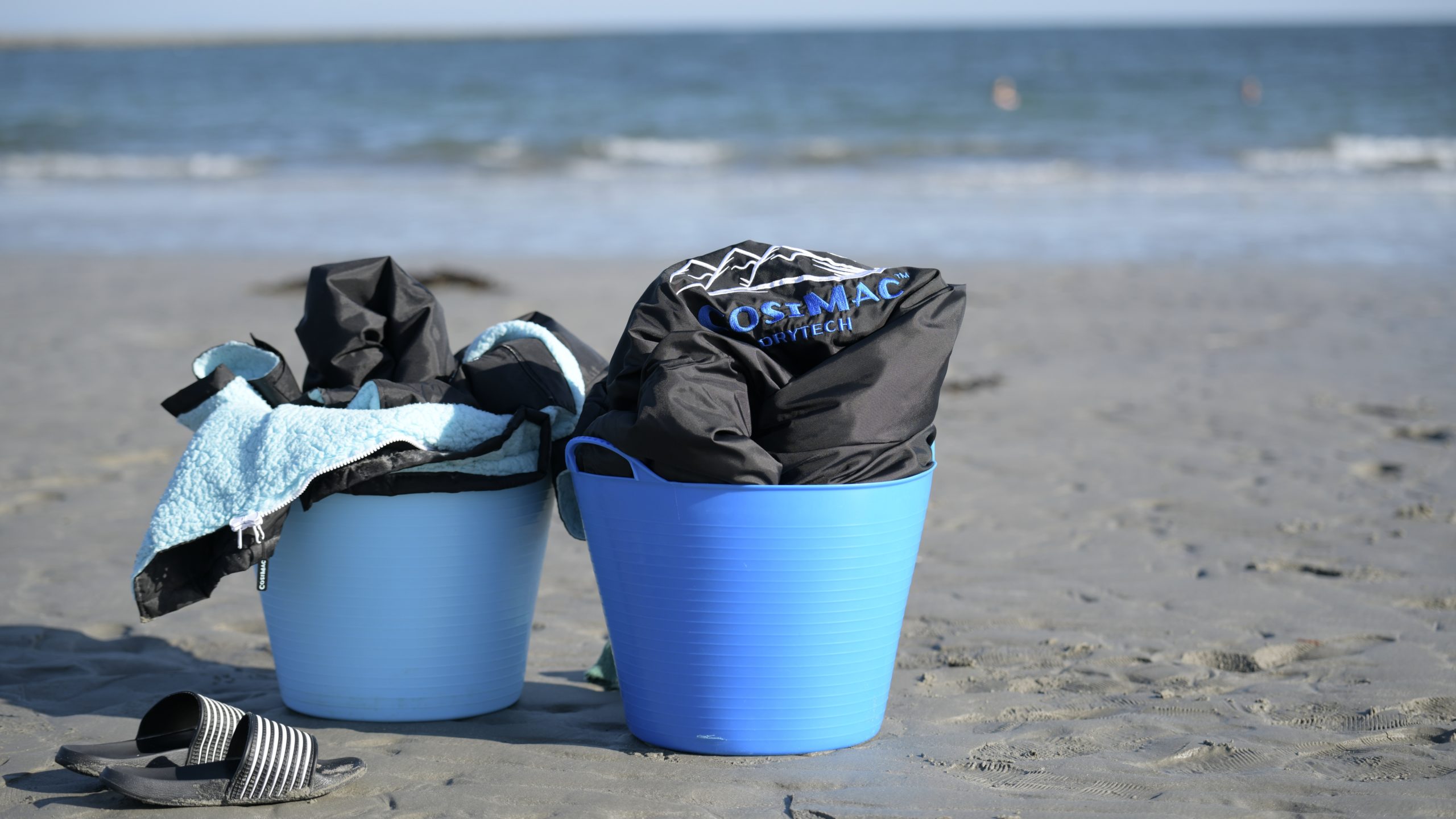Some time in the past, garlic was heralded as a natural general purpose medical panacea, providing prevention from the common cold, chesty coughs and many other wide ranging ailments with beneficial claims made akin to those of travelling salesmen in the wild west with their wonder elixirs. Some said it would take about a year for the effect to kick in. With that generous effectiveness window, many of us didn’t have the patience to wait it out and likely moved on. After all these years, the jury is still out by and large on many of the health claims of garlic, but there is one thing certain about it, and that is it does make food taste a lot better (but only if you like garlic). The same can’t be said of the recent explosion of interest in wild swimming or to use a more formal term, cold water immersion, as anecdotal evidence constantly washes up from the high tide of water activity, of its almost instant beneficial effects. So, what is wild swimming, who amongst us is doing it and why? Read on…
What is wild swimming or cold water immersion?
Well, essentially you subject yourself to water of a particularly low enough temperature such that your body has a momentary ‘fright or flight’ response – basically a big shock to the system. Physiologically, it takes your breath away until you become acclimatised or over multiple immersions, become desensitised. Your heart beats faster and adrenalin generally pumps around your veins. That experience can be readily enjoyed on our coastal offerings around the peninsula, though you might prefer a lake or river but it has to be said that wading down the beach is somewhat more convenient. As an alternative and catching on in some Scandinavian countries is cold shower immersion. Similar to cold sea swimming in many ways but there is a marked difference, namely that there is something motivating about joining a group of like minded wild swimming devotees and plunging into the salty sea. We should mention in passing too that cold water immersion has been used around the Club in the past as an aid to performance recovery. Conor ‘Buzz’ Gilmore was a stalwart of the technique and could be seen regularly immersed in a large blue container filled with cold tap water after a training session. The technique is still in fashion, though we did hear from Stephen Keith last year that a dip in the sea at Knockinelder followed a County training session.
So who are the brave Club souls devoted to this activity?
Within our own Club there appears to be a disproportionate representation of high tide chasers, with the pendulum swinging mostly towards the ladies. On a visit to Cloughey beach, we found our first four devotees. Having waded out to a decent depth and distance but unable to escape the reach of the telephoto lens, Eugene Gilmore and Cara McCarthy looked comfortable bobbing on the waves if not down right happy to be immersed.
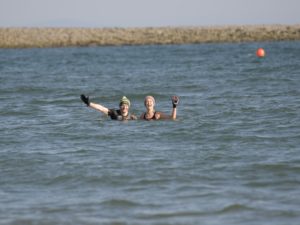
Eugene and Cara waded out near the Ringbuoy (WS1)
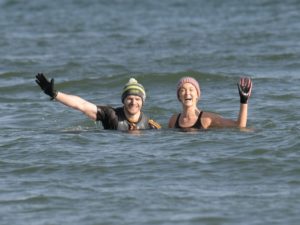
Clearly pleased and comfortable with their wild swimming (WS2)
Just a bit further down the Costa, we came across Nicola Boyd and Tara Corcoran. On their walk out from the shore, Tara had this to say about the attraction of wild swimming in the sea, “To be honest, for me, Nicola got me into this. Nicola and a friend were training for a triathlon and swimming in the sea was a part of that. So, I gave it a go and now try not to miss an opportunity of getting in”.
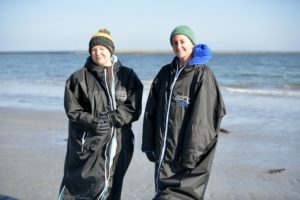
Tara Corcoran and Nicola Boyd on their way out for a high tide swim (WS3)
Nicola added, “During lockdown I discovered that I had some more time on my hands and despite the training for the triathlon in the past, when you have this on your doorstep it’s kind of hard not to have a paddle, then up to your knees and before you know it, your up to your neck on a regular basis. We have even discovered that there are local’s swimming near here that are in their eighties!”.
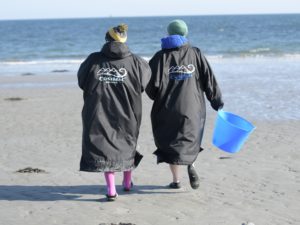
A short stroll down the beach and the sea awaits (WS4)
“Initially it was really difficult and I wouldn’t lie, it was painful at times. The pain was coming right from your bones but eventually with perseverance, you start to build up a degree of resilience and after a couple of weeks, you cross the barrier of hesitation. That’s when it all comes together. A full body immersion is a complete body reset. You become so focussed that you stay in the moment and that helps to clear your head. That’s me sorted for the entire day, maybe even two!”.
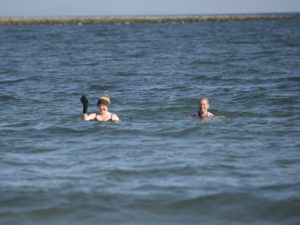
Never out of their depth, Tara and Nicola have mastered the cold immersion (WS5)

South Rock lighthouse, Cloughey, provides a distant focal point for our wild swimmers (WS6)
To undertake wild swimming, you need a few basic accoutrements to make the experience all the more enjoyable, like an App or web site that tells you about tidal times. Yes, that’s essential if you don’t want to walk half way out to the Isle of man before getting your toes wet. Then there’s the Mac. The after swim body warmer. Some come with pockets for hot water bottles and wrapped up cozily in your Mac, just occasionally there’s coffee/tea, cake and craic up on the bank and plans made for another rendezvous.
So what are the actual benefits to be had from this external elixir?
Over on the west of the peninsula just off Kircubbin’s shore road we found Niky McGrattan, Joanne Clarke, Nicola Gilmore and Carol-Anne Ennis. There are a few personal challenges if not fears to be overcome before the wild environment can be tamed just a bit and the group talked openly about conquering their challenges and enjoying the benefits.
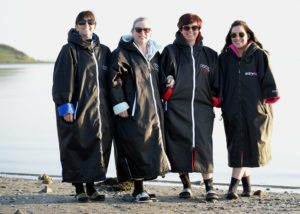
Niky, Joanne, Nicola and Carol-Anne all set for a late evening plunge (WS7)
For Niky, it was “Overcoming the waves. Yes that was my own personal hurdle and I’m glad to say it’s not a prominent concern for me anymore and from this I actually feel more confident in and around the water”. For the rest of the group, the consensus was that the sheer cold on the extremities was a challenge to overcome but neoprene boots and gloves have made that a lot more tolerable.

Dryrobes and CosiMacs make wild swimming a little bit more manageable (WS8)
Niky added, “For our group it all started with Hollie Woods. Nicola then joined her I think, then Joanne and I was the last one to be convinced of the benefits. I guess we were all nervous about going in the first few times but you really do get a buzz when you get out and that’s worth the effort in the first place”.
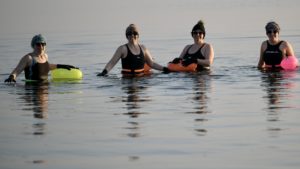
On their way out to getting the full body immersion sensation (WS9)

Ballycran’s ladies wave with delight as they wade out far into the bay (WS10)
Joanne Clarke, “After coming out, you feel that you have more energy, maybe sometimes a little bit hyper. Then later that night, I definitely sleep better and it certainly helps with your mood”.
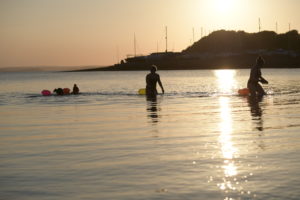
Job done, moods high and a good night’s sleep ahead (WS11)
There maybe others out there amongst us that have been bit by the cold water immersion bug, in fact Paddy Gilmore we hear has an interest but his brother and past Chairperson, Shane Gilmore, wouldn’t be easily convinced that using a diving bell suit would qualify him as a wild swimmer. The one thing that everyone claims is that they will keep doing it, lockdown or not. If you haven’t tried it, then why not? At the very worst it can only be a bit like Vegemite, you’ll either love it or hate it. Vegemite, now there’s a thing. The potted Australian wonder spread. It does make you wonder then if our friends and family in the Central Coast GAA would swap their balmy average sea temperature of 20 degrees celsius for our 9 degrees celsius considerably colder sea waters…okay, maybe not. Yes, there may be unknown benefits to be discovered yet from a dip in a warm sea and drying off in the warm breeze.
If you are interested in the topic of cold water immersion, particularly cold showers and their health and wellbeing benefits, then why not have a listen to the excellent BBC Podcast by Dr. Michael Mosley here…
For a deeper dive into the health benefits (or not) of Garlic, look here…
https://www.consumerreports.org/diet-nutrition/the-health-benefits-of-garlic/
And lastly, please exercise caution if you want to enjoy the benefits of our coastal gems. Be sea aware, take a friend, follow local advice on currents, tides, stay within your depth and don’t stay in too long. Never EVER jump into a cold water facility where you cannot touch the bottom.
Thanks to our Ballycran swimmers for undertaking the rigours of a photoshoot and interviewing. We hope that this article will inspire a few more to explore the potential benefits of our local sea resources.
